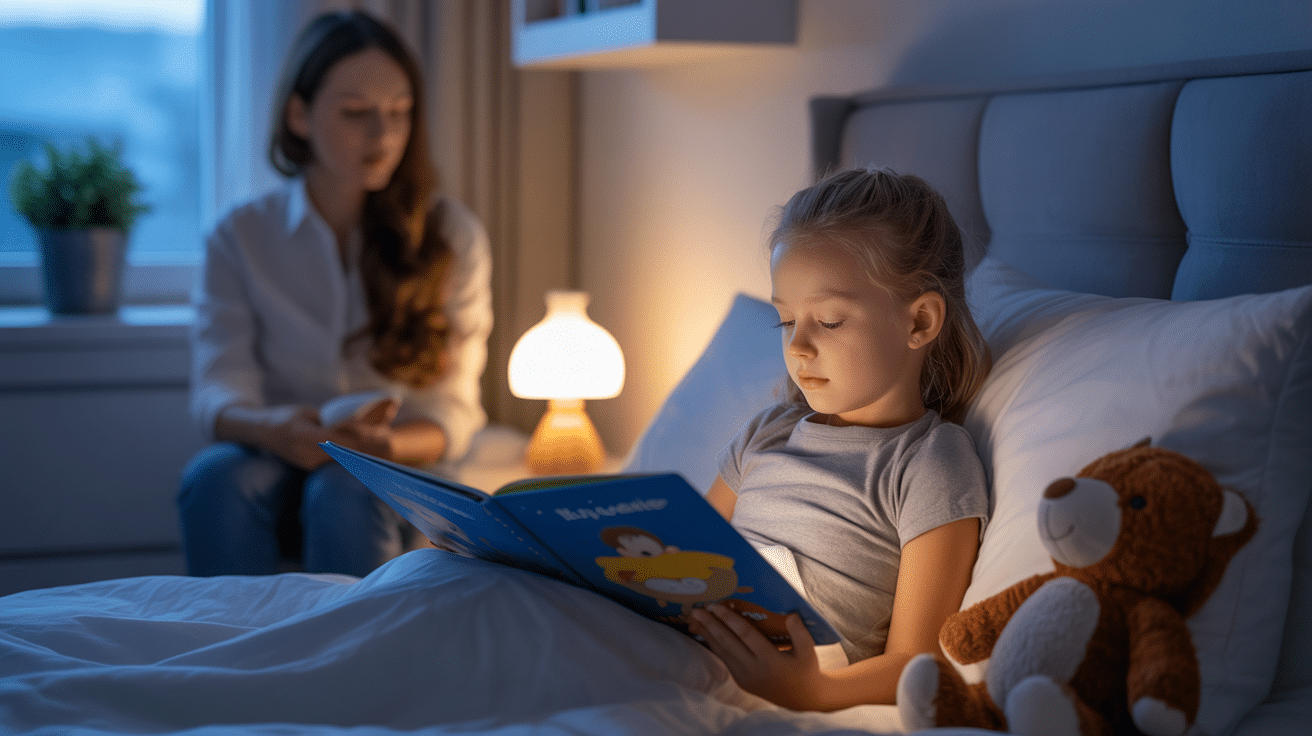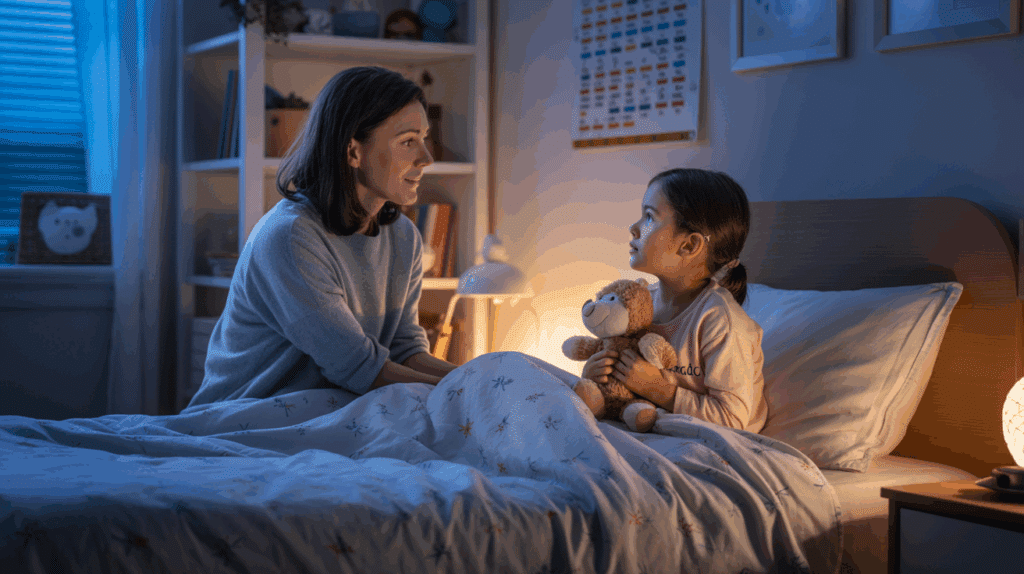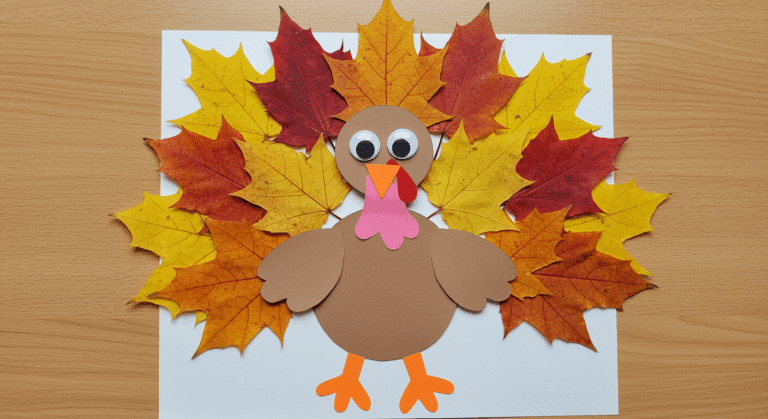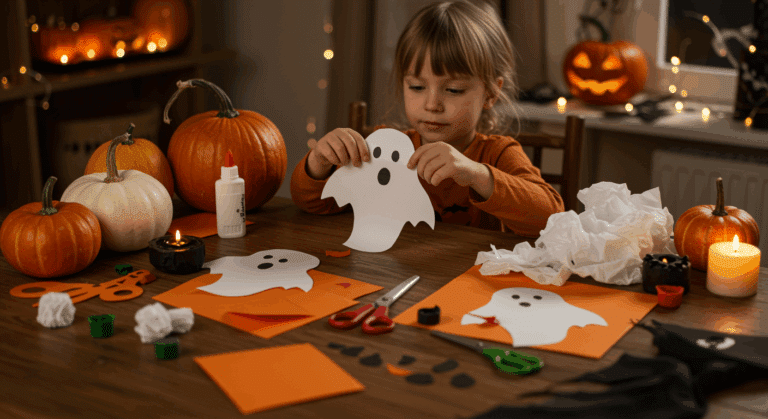Bedtime becomes a battle when your 10-year-old starts worrying about tomorrow’s test or monsters under the bed.
Many parents watch their children toss and turn, mind racing with fears that seem small to adults but feel huge to kids. Sleep should be peaceful, not stressful.
This blog will go into bedtime anxiety in 10 year olds, practical ways to calm your child’s bedtime worries and create a more relaxed nighttime routine. You’ll learn simple techniques that work, plus understand why anxiety hits hardest when the lights go out.
Why do 10-Year-Olds Experience Bedtime Anxiety?
Bedtime anxiety in 10 year olds is due to a combination of developmental, emotional, and environmental factors. Common triggers include fear of the dark, separation anxiety, and worries about school or social situations.
At this age, children may also feel stress from academic pressures, changes in routine, or family issues such as parental stress or conflict. Nighttime often magnifies these worries because distractions fade, leaving children alone with their thoughts.
Overstimulation from screen time before bed and unsettling experiences, like nightmares or hearing scary stories, can further contribute to bedtime anxiety. Understanding these underlying causes is crucial for parents to provide reassurance and create a calming bedtime routine that helps children feel secure
Recognizing the Signs of Bedtime Anxiety in 10 Year Olds
Bedtime anxiety in 10-year-olds can be challenging for both children and parents. Recognizing the signs early is key to providing the right support and helping your child develop healthy sleep habits.
Here are some common signs of bedtime anxiety in 10 year olds.
- Difficulty falling asleep, often lying awake with racing thoughts or worries.
- Frequent night wakings or trouble staying asleep, sometimes due to nightmares or specific fears.
- Reluctance or refusal to sleep alone, expressing fear of being by themselves at night.
- Complaints of physical symptoms like stomach aches, headaches, or feeling nauseous at bedtime.
- Increased irritability, mood swings, or daytime sleepiness due to poor sleep quality.
- Regression in sleep skills, such as needing a comfort object or parental presence to fall asleep.
- Fear of the dark or heightened anxiety after hearing or seeing something unsettling.
- Behavioral changes, including more frequent requests for water, snacks, or bathroom trips, as stalling tactics.
- Difficulty concentrating or changes in appetite linked to sleep disturbances.
- Expressing worries about school, friendships, or family issues that surface at bedtime
Strategies to Reduce Bedtime Anxiety in 10-Year-Olds

Bedtime anxiety can make nights difficult for 10-year-olds and their families.
However, there are proven strategies that can help children feel more secure and relaxed at bedtime. By implementing these approaches consistently, parents can support their child’s emotional well-being and promote healthier sleep patterns.
1. Establish a Consistent Bedtime Routine
A predictable bedtime routine helps reduce bedtime anxiety in 10 year olds by signaling to your child that it’s time to wind down and feel safe. Start the routine about 30 to 40 minutes before bed, including calming activities like reading, a warm bath, or gentle music.
Consistency is key; try to keep the same order of activities and bedtime each night, even on weekends. This regularity reassures your child and helps regulate their internal clock, making it easier for them to fall asleep.
2. Limit Screen Time Before Bed
Electronic devices emit blue light, which can stimulate the brain and interfere with the body’s natural sleep-wake cycle. To reduce bedtime anxiety, turn off screens at least an hour before bed. Encourage alternative relaxing activities like reading, drawing, or listening to soft music.
This break from screens allows your child’s mind to unwind and prepares their body for restful sleep, making it easier to settle down at night.
3. Address Specific Fears Directly
Children often develop specific fears, such as fear of the dark or monsters under the bed. Address these fears by talking openly with your child and validating their feelings. Use practical solutions like nightlights, checking the room together, or providing a comfort object.
By acknowledging and tackling their worries, you help your child feel understood and empowered to cope with their anxiety.
4. Create a Comforting Sleep Environment
A safe and cozy bedroom can significantly ease bedtime anxiety. Ensure the room is cool, quiet, and dark, using soft lighting or a nightlight if needed.
Provide comfortable bedding and allow your child to have a favorite stuffed animal or blanket nearby. Making the sleep environment inviting and secure helps your child associate bedtime with safety, which can reduce nighttime fears and promote better sleep.
5. Practice Relaxation Techniques and Bedtime Meditation
Incorporate relaxation exercises, such as deep breathing, guided imagery, or short bedtime meditations, into your child’s nightly routine. These techniques help calm racing thoughts and relax the body. You can use age-appropriate guided meditations or calming scripts designed for children.
Practicing these skills regularly can make it easier for your child to manage anxiety and transition smoothly into sleep.
6. Have a Bedtime Chat to Process Worries
Spend a few minutes before bed talking with your child about their day and any worries they might have. This positive, reassuring time allows your child to express their fears and process emotions, reducing anxiety.
By making this a regular part of the bedtime routine, you show your child that their feelings matter and that you are there to support them, which can make bedtime feel less daunting.
7. Offer Positive Reinforcement
Recognize and praise your child’s efforts to manage their bedtime anxiety, no matter how small. Positive reinforcement boosts their confidence and encourages them to continue practicing healthy sleep habits.
Simple rewards, like extra story time or a special breakfast, can motivate your child and help them feel proud of their progress, making them more likely to adopt calming routines each night.
8. Use Transitional Objects for Comfort
A transitional object, such as a favorite stuffed animal, blanket, or even a parent’s item, can provide comfort and security at bedtime. These objects help children feel connected to their caregivers even when alone, making it easier to relax and fall asleep.
Allowing your child to choose their comfort item can give them a sense of control and reassurance during anxious moments.
9. Rearrange the Room to Reduce Fear
Sometimes, the layout of a bedroom can contribute to nighttime anxiety. Work with your child to identify areas that feel scary or uncomfortable, and rearrange furniture or lighting to make the space feel safer.
Moving a bed closer to the door, adding a nightlight, or removing shadows can help your child feel more secure and less anxious about going to sleep.
10. Encourage Physical Comfort and Relaxation
Ensure your child’s pajamas and bedding are comfortable and that the room temperature is just right, not too hot or cold. Encourage gentle stretching or yoga poses before bed to release physical tension.
Physical comfort is an important part of feeling safe and relaxed, and addressing these needs can significantly reduce bedtime anxiety and improve sleep quality.
Supporting Your Child: Communication and Emotional Tools
Supporting your 10-year-old through bedtime anxiety requires open communication and the right emotional tools. By fostering trust and validating your child’s feelings, you can help them feel secure and understood at night.
Here are some effective ways to support to improve bedtime anxiety in 10 year olds.
- Validate Their Feelings: Acknowledge your child’s worries and let them know it’s normal to feel anxious sometimes. Avoid dismissing their concerns; instead, listen patiently and work together to find practical solutions. This validation helps your child feel respected and less alone in their experience.
- Encourage Open Conversations: Set aside time each day to talk about your child’s thoughts and fears, especially before bedtime. Creating a safe space for these discussions allows your child to process emotions and reduces the burden of unspoken worries.
- Practice Relaxation Techniques Together: Teach your child calming strategies like deep breathing, progressive muscle relaxation, or guided imagery. Practicing these techniques together before bed can help ease anxiety and promote restful sleep.
- Share Positive Reinforcement: Celebrate your child’s efforts to manage their anxiety, no matter how small. Positive reinforcement, such as praise or small rewards, builds confidence and encourages continued progress.
- Talk About Dreams and Nighttime Worries: Discuss any dreams or recurring worries your child experiences. Talking about these topics before bed can help demystify fears and empower your child to face them with your support.
- Spend Quality Connection Time: Engage in bonding activities like reading a story or sharing a quiet moment before bed. This connection reassures your child, making them feel safe and supported as they transition to sleep.
- Encourage Gradual Independence: While offering reassurance, gently encourage your child to develop independent sleep skills. Gradually reducing your presence at bedtime helps your child build confidence in their ability to manage anxiety on their own.
The Bottom Line
Improving bedtime anxiety in 10 year olds takes time, but small changes make a big difference.
Start with one or two strategies that feel right for your family. Maybe it’s the breathing exercise, or perhaps creating a worry box works better for your child.
Sweet dreams are possible when children feel heard, safe, and supported. Your efforts to address their nighttime worries today will help them develop healthy sleep habits that last a lifetime.















